Intermediate bowlers looking to improve their game must build an arsenal of bowling balls properly. With that said, a bowling ball will not fix a liability in your physical game. So don’t think you can just purchase a higher average. With so many bowling balls out there today, how do you know which ball is the next ball for you?
In this article, we’ll arm you with the information necessary for you to decide.
High vs. slow ball speed
The goal when choosing a new bowling ball is not to replicate the same ball motion your other bowling ball(s) is giving you.
Your benchmark ball is your go-to bowling ball that helps you read the lane. When you decide your benchmark ball isn’t needed, which ball do you put in your hand?
Never make an adjustment off of a bad shot. So if it’s you, own it, but if it’s the ball, change it.
The information we are about to cover you will find on bowling ball manufacturers' websites when looking to purchase a new bowling ball:
- • Core
- • RG
- • Differential
- • Coverstock
Knowing your ball speed will help you both determine which bowling balls make the initial list when trying to choose which one is best for you.
Asymmetrical bowling ball cores are heavier and larger in size than symmetrical bowling ball cores.
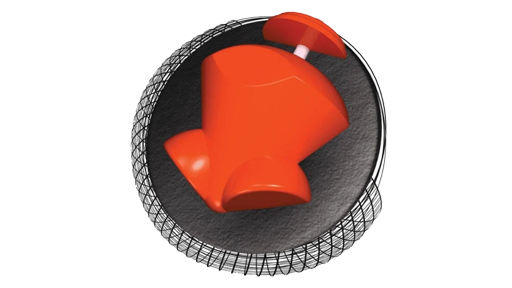
Asymmetrical cores will break earlier than symmetrical cores on the lanes.
- • If you are a higher-speed player, bowling balls with asymmetrical cores are for you.
- • If you are a slower-speed player, bowling balls with symmetrical cores are for you.

RG is when your ball begins to rev up.
- • Low RG bowling balls rev up earlier on the lane, with more mass on the bottom of the core.
- • High RG bowling balls rev up later on the lane and most of their mass is located on the top of the core.
Higher-speed players will match up better with low RG bowling balls, and slower-speed players will match up better with high RG bowling balls.
Bowling balls and their cores can rotate on two different axis points.
The differential is the number used by bowling ball manufacturers to tell us to track flare potential on a bowling ball.
Track flare is the amount of surface on the bowling ball that touches the lane.
A higher differential results in higher flare and higher hook potential.
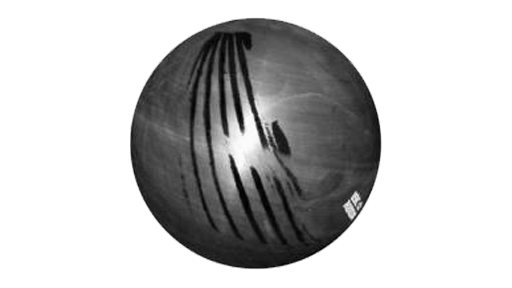
Medium differential results in medium flare and medium hook potential.
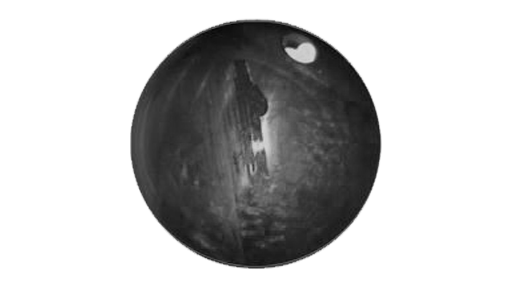
Lower differential results in lower flare and lower hook potential.
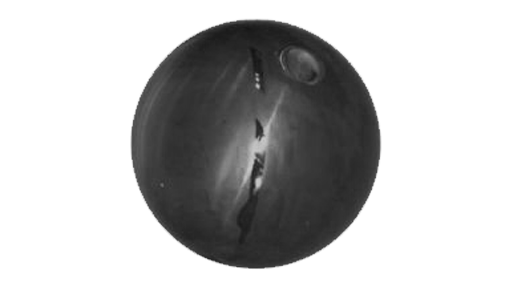
There are many different coverstock out there. We’re going to simplify it by saying dull and shiny.
Duller-finished coverstocks are considered to be strong, aka aggressive bowling balls.

A stronger ball will have less right-to-left hook down the lane because it has exerted much of its energy on the first half of the lane.
This means it hooks earlier when looking at the lane front to back with less back end reaction.
The shinier-finished coverstock is considered to be weak bowling balls.
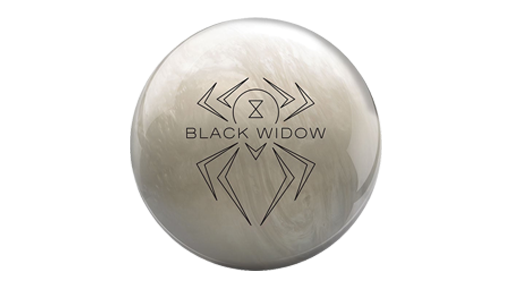
A weaker bowling ball will skid through the heads more than an aggressive bowling ball and show more right-to-left movement on the backend of the lane.
| HIGHER SPEED PLAYER | SLOWER SPEED PLAYER |
| Asymmetrical core | Symmetrical core |
| Low RG | High RG |
| Differential depends on your needs. | Differential depends on your needs. |
| Coverstock depends on your needs. | Coverstock depends on your needs. |
Pin placement
Although 75% of a bowling ball’s reaction comes from having the proper surface applied to its coverstock, the layout is the fine-tuning that makes it yours.
Have you ever noticed that dot or circle on your bowling ball and asked, “What is that?”.
That dot represents the top of the core inside the bowling ball.
Pin placement creates the overall hook and flare potential when laying out a bowling ball.
When the bowling ball rolls down the lane, it revolves around its axis. There are two points at the ends of the axis: the negative (NAP) and the positive axis point (PAP).
The NAP exists but is unimportant to bowlers because it cannot be seen while the bowling ball is in motion. Kind of like the dark side of the moon…
Anyhow, the PAP is important because it can be seen throughout a shot, and the bowling ball’s reaction is influenced by how far the pin and core are away from the PAP.
Your PAP is personal to you and you only. Check out this video on how to identify PAP.
Pin Closer to the PAP (Positive Axis Point)
The PAP is identified below with the white piece of tape. The pin is illustrated with the yellow circle drawn on the bowling ball.
This pin placement creates an earlier hook with less backend reaction. This layout is ideal for higher-volume oil patterns.
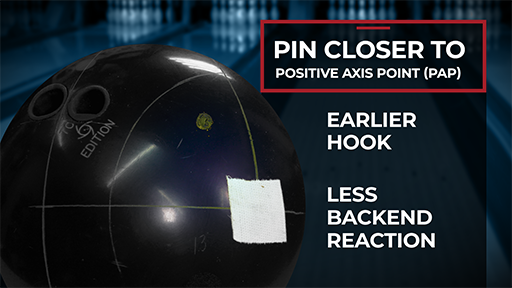
Pin Farther From PAP (Positive Axis Point)
This pin placement creates more skid and more backend reactions. This layout is ideal for lower-volume oil patterns. It’s also good when the lanes transition and become drier.
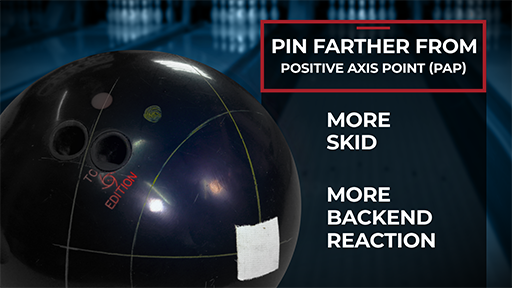
Pin Leverage Position
Both yellow circles below represent pin placement 3 ⅜ away from the PAP. The number on the X-axis can range from 0 to 6 ¾ inches. At 3 ⅜ inches, the most flare and hook potential is created.
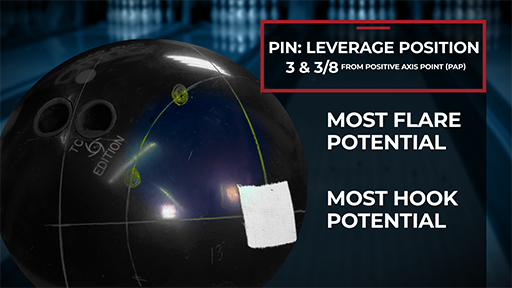
Pin Higher Than the Finger Holes
This pin placement delays the hook, providing a strong backend reaction. This is a good layout for lane transition and lower oil volume patterns.
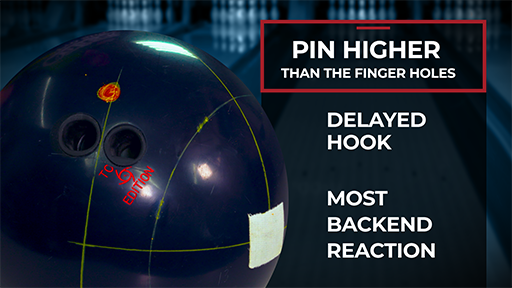
Pin Lower Than the Finger Holes
This layout is good for lower-volume patterns and can be used as a ball to change out when the lanes transition.
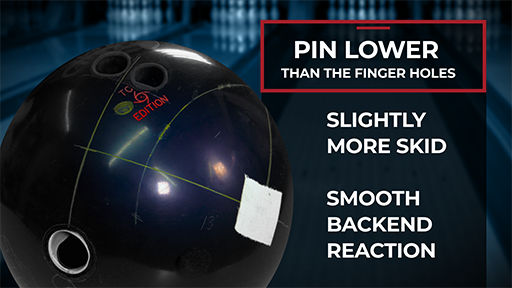
To conclude, higher and lower speed players can widdle down choices for a new ball by choosing the right core and RG respectfully.
From there, it’s a preference for coverstock, differential, and pin placement. It’s a big topic, so leave your thoughts below if you have questions or comments.

What is considered high speed and low speed. I can slow down to about 11mph and go up to 14.5mph
What does it mean to "widdle"? I always thought the saying was to "Whittle"
Thank you for this information. I'm 78 and recently got married to a lady who has bowled three 300 games. I haven't bowled in over 40 years and this information will help me to get closer to her caliber bowling.
What is considered high speed and low speed?
What is considered “high speed” and “low speed”?
Finally I can understand what all of this stuff means. So much easier to read and understand rather listening to someone explain it. Pretty sure I know what I need now. Great article folks. Thank you sooooo much.